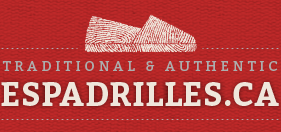
How it's made
Braiding the jute thread into a rope
The essential part of the traditional espadrille is the quality of the rope used to make the soles. Our good friend Jose Luis from the village of Cervera takes care of making all of the braided rope for the whole village with 1960’s machinery.
The thread created from jute is strong, and it also has exceptional insulating properties, low thermal conductivity, and antistatic characteristics. Jute fiber is 100% bio-degradable and recyclable and thus environmentally friendly.
Followed by shaping the soles by hand
And here is Vicente Remón, one of the last masters of the espadrilles in the region of La Rioja. He shows us in this video the technique used to shape the sole of the espadrille. The metal turntable is adjusted using metal pins as the desired shoe size. All espadrilles available at Espadrillestore.originate from the village and are shaped one by one, without any shortcut.
The traditional soles are hand stitched
Up to the 70's, the sole of the espadrille was traditionally sewn by hand on a special bench called "banco Alpargatero." This sole was made of jute or hemp fiber and using a handheld punch. For many centuries the old fashioned espadrille was generally used by farmers, soldiers and clergy man.
In the next video, see how Paco, one of the last craftsmen in Spain to make these jute rope soles by hand, shows his incredible craftsmanship, demonstrating the fine art of making a traditional rope sole, using a bench which has been used for many generations, passing from father to son. EspadrilleStore offers exclusive espadrilles handmade by our friend Paco.
The taylor's workshop
And here is the master tailor Ramon‘s workshop,. He and his wife Paquita have been making espadrilles over thirty years. It is in this tiny shop that all the different elements that make up a perfect espadrille are cut. Paquita is responsible among other things of finishing some high-end models that need special attention. Ramon is a typical villager, talking loudly, making you feel welcome, and working hard while singing old tunes and cursing our computerized society. And of course, because hard work makes you thirsty, he joins his friends to enjoy a well-deserved pause (La Rioja is known for its red wine). The ambience is terrific.
The hand stitch: the heart and soul of the real espadrille
An enormous charm emanates through the village as grandmothers (abuelas) sit at the threshold of a door, busy sewing espadrilles while recounting the latest gossip in the village.
As you can watch in this video, all our shoes are hand sewn. Today this craft, still widespread up to the 60s, has been replaced by espadrilles machine produced in China, Bangladesh and elsewhere. Fortunately our village continues producing hand sewn espadrilles and we are happy to make our contribution to the revival of this ancient craft.
When a espadrille is hand-sewn, it gains in strength and authenticity. Sewing a pair of espadrilles takes about 25 minutes per pair and the tip of the espadrille is the most technical and difficult to achieve. Our abuelas have all the know-how inherited from their mother.
Paquita
Rosa
La Reina





